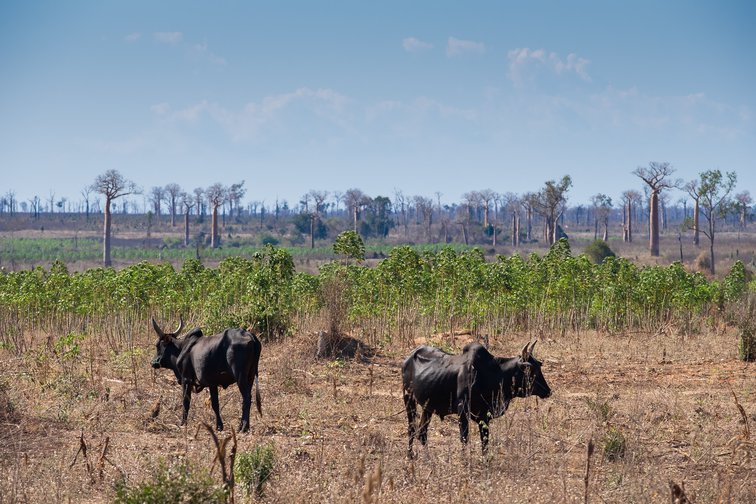Two good reasons to eat fewer animals. Shifting to a flexitarian diet will help to prevent pandemics, fight climate change, and feed the world sustainably.
GUEST CONTRIBUTOR: Giulia Wegner
June 01st 2020

Over the past year the world has witnessed an alarming succession of environmental disasters. Millions of hectares of forests have been incinerated in Amazonia and Australia. Floods have submerged whole cities like Venice and its historic and cultural heritage. An ever-increasing number of cetaceans, turtles and birds are dying in agony due to the ingestion of plastic. And most recently, the global Covid-19 pandemic reminds us that messing with our planet can have consequences that are deadly.
The past 60 years have been characterised by the increasingly frequent emergence of new ‘zoonoses,’ which are infectious diseases transmitted from animals to humans – as is most likely to have been the case with the coronavirus. The majority of these zoonoses (more than 150) were transmitted by wild animals, including Ebola (1976 in western Africa), HIV (identified in 1981 in the USA), SARS (2003 in China), and most recently Covid-19.
This may partly be due to climate change, which alters temperature and rainfall patterns in ways that favour disease carriers like mosquitoes. Melting glaciers may also release viruses that have been buried for thousands of years. But the rise in new zoonoses is primarily caused by the ways in which we are pushing into, and extracting resources from, the few remaining pristine ecosystems left on the planet.
When the Amazonian rainforest is burned to obtain cheap land for cattle ranching, or African territories are cleared to extract timber and minerals like coltan for electronic devices, or uncharted landscapes are penetrated to hunt exotic animals and sell their meat, skins, ivory, and body parts for presumed medicinal uses, humans come into contact with previously‑isolated populations of wild animals that host hundreds of thousands of viruses and bacteria to which we’ve never been exposed.
These microorganisms aren’t new – viruses have been on planet earth for more than three billion years – but our interactions with them are quite recent. This explains why the majority of new infectious epidemics are linked to deforestation, which creates novel rural landscapes where wild animals and humans intermingle, and which also facilitates the entry of illegal hunters into pristine ecosystems.
Certain species of bats and rodents prosper in these modified landscapes, and due to their high numbers and tolerant immune systems these animals act as ‘reservoir’ species that host viruses asymptomatically. Once these viruses enter the human body they can be lethal. Many viruses also make use of an ‘intermediate vector’ through which they can evolve and transit from reservoir species to humans.
For example, insufficiently-cooked meat from wild animals is one of Ebola’s main vectors, where the animals involved were probably infected by eating fruits that were partly consumed by bats that host the virus. The Nipah epidemic in Malaysia in 1998 broke out when a large intensive pig farm was established together with fruit orchards at the edge of a forest, with the virus transmitted first from bat to pig through fruit contaminated with the bat’s saliva and urine, and then from pig to human through direct contact with sick pigs or their contaminated tissues.
Thus, as long as we keep encroaching into the last uncontaminated ecosystems on earth to extract resources, new infectious diseases will continue to emerge. As explained by Alanna Shaikh, an expert in global public health, even if every country in the world was able to develop effective protocols to contain new disease outbreaks by identifying new viruses as soon as they emerge, immediately treating infected people, and sharing all the necessary information so that other countries can be prepared, new viral disease outbreaks will be inevitable so long as we continue to abuse our planet.
The sharing of diseases between animals and humans reminds us of something fundamental: we are animals too, and as such form an integral part of nature. The only way to mitigate environmental disasters is to learn to accept and respect this basic truth.
The causes of ecosystem disruption are several, but they are all linked to the overconsumption of natural resources. One form of consumption in particular lies at the root of both the increasing risk of zoonotic pandemics and global warming: the consumption of animal‑sourced foods. As is well known, climate change is caused by greenhouse gas emissions, especially from electricity and heat production (which account for 25% of the total); deforestation, crop cultivation and livestock ranching (24%); industrial production (21%), and transportation (14%).
In order to curb emissions and mitigate climate change, governments tend to focus on the energy and transport sectors, but the second of these areas – the global food system – is also key, especially livestock production. The farming of poultry, pigs, cattle, goats and other livestock is responsible for between 72% and 78% of agricultural food-related greenhouse gas emissions. This is due to the fact that livestock is the world’s largest user of land and water resources, and also to cattle gut fermentation (which produces methane), and manure-related gas emissions.
With its high requirements for land, water and feed, livestock production is also one of the main causes of the habitat destruction that brings humans into increasing contact with wild animals. Since the expansion of livestock and feed production occurs predominantly in tropical countries, the risk of new zoonoses is also concentrated in tropical forests which are characterised by high mammal species diversity, and which are undergoing land conversion for crop and livestock production. Moreover, due to their high density and low genetic diversity, intensive livestock farms can also act as amplifiers for the transmission of new pathogens.
There is a growing consensus among the scientific community that greenhouse gas emissions cannot be sufficiently mitigated without a radical reduction in the consumption of animal‑based foods. The Oxford Martin Programme on the Future of Food and the Special Report on Climate Change and Land of the UN’s Intergovernmental Panel on Climate Change (IPCC) both assert that the target of keeping global warming well below 2°C won’t be met without intensifying sustainable agriculture, reducing food loss and waste, and adopting diets that are low in animal-sourced protein.
A so called ‘flexitarian’ or ‘planetary health’ diet consists of large amounts of plant-based foods like vegetables, fruits, legumes, wholegrains, nuts and seeds, along with modest amounts of animal-based foods such as fish, poultry, eggs and dairy produce and very low amounts of red meat (i.e. beef, pork and lamb). A global shift to a flexitarian diet has the potential to reduce food‑related greenhouse gas emissions by 56% and feed more than nine billion people by 2050 in an environmentally-sustainable manner.
The EAT Lancet Commission on Food, Planet, Health in 2019 reached the same conclusions. In addition, the commission highlights how a plant‑based diet rich in fruits, vegetables, nuts, legumes and wholegrains , along with cutting unhealthy products like red meat, added sugars and highly processed foods, could prevent approximately 11 million deaths per year (or 19 – 24% of total adult deaths). High levels of consumption of red and processed meat are linked to chronic diseases such as diabetes, heart diseases and some cancers.
Therefore, in order to reduce greenhouse gas emissions and the risk of new epidemics, it’s crucial that each one of us begins to shift to a flexitarian diet as soon as possible, as well as purchasing more sustainably-produced food (like organic products) and eliminating food waste from our households.
The Covid-19 pandemic shows that each and every one of us is vulnerable to the consequences of environmental degradation. Therefore, we all share the responsibility to act in order to prevent land and water pollution, floods, drought, famine, and epidemics from becoming increasingly prevalent.
In evolutionary terms, what distinguishes humans from other animal species is not, as many suppose, the capacity to feel emotions or express oneself through technology and art. Other animal species share our capacity to feel fear, joy, pain and expectation, and to develop knowledge and transmit it to their offspring.
Rather, what distinguishes us from other animal species is our cerebral capacity to imagine something that doesn’t yet exist, and communicate it to the rest of our community in words and images so that we can turn abstract ideas into concrete action. But to do so requires that we activate this capacity.
We are already feeling the consequences of our inaction. Our children and grandchildren, and those human communities and non-human animals who lack the privilege of choice that’s available to many of us in wealthy societies, will have it much worse if we do nothing.
First published on Open Democracy 26May
Join Mailing List
